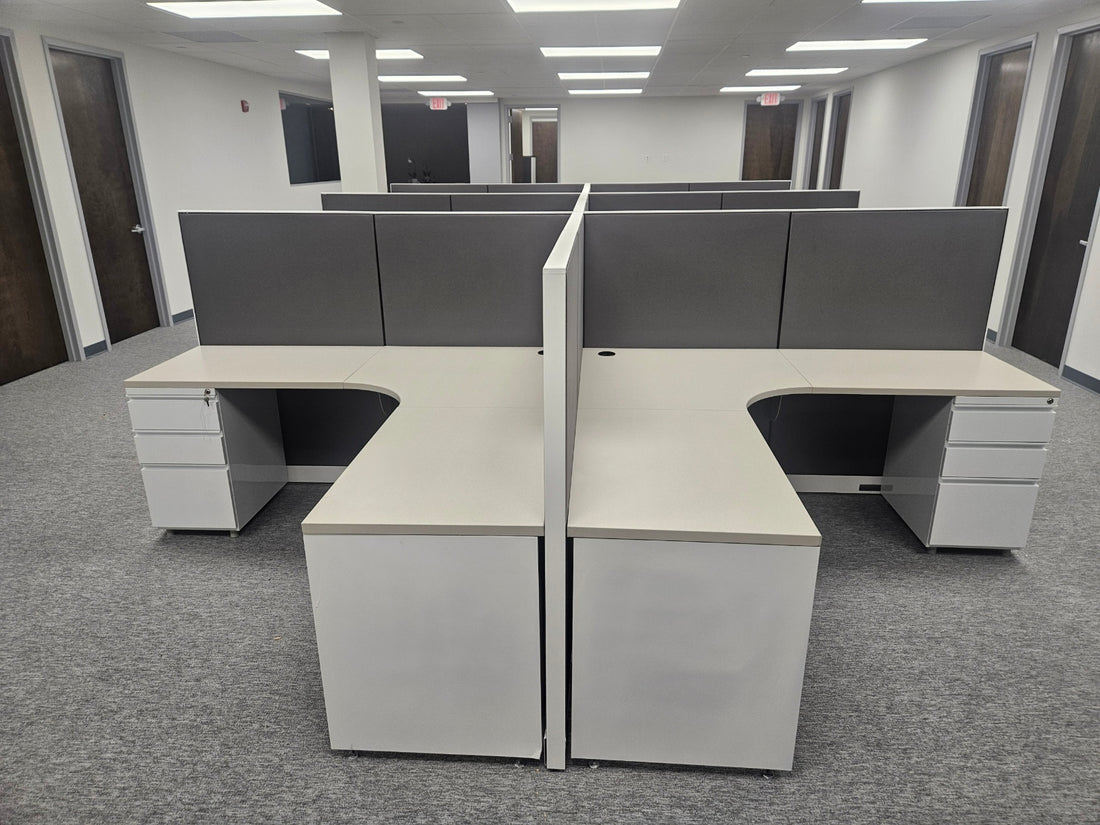
Understanding the Different Sizes and Styles of Office Cubicles
Share
A Guide to Choosing the Right Fit
Cubicles are a staple of many office environments, offering a balance of privacy and collaboration while optimizing space. However, not all cubicles are created equal. They come in various sizes, heights, materials, and colors, allowing businesses to tailor their office layout to specific needs and aesthetics. Here’s a guide to understanding the different dimensions and design options available for office cubicles.
1. Cubicle Dimensions: Height, Width, and Depth
Cubicles are available in a range of sizes, making it easy to find an option that fits your office space and employee needs. Understanding the standard dimensions can help you choose the right cubicles for your workspace.
-
Height:
- Short (42-48 inches): Low-height cubicles offer minimal privacy but allow for easy communication and a more open feel. These are ideal for environments that prioritize collaboration and visibility.
- Mid-height (54-66 inches): Mid-height cubicles provide a balance between privacy and openness. They offer more seclusion than low-height cubicles while still allowing for interaction over the top of the panels.
- Tall (70-85 inches): High cubicles create a private workspace similar to a mini office. These are best for roles that require concentration and minimal distractions.
-
Width:
- Small (4x4 feet): Compact cubicles are ideal for offices with limited space. They provide just enough room for a desk, chair, and some storage.
- Medium (6x6 feet): A standard size that offers more room for a comfortable workstation, with space for a computer, desk accessories, and personal items.
- Large (8x8 feet or larger): These spacious cubicles are suitable for managerial positions or tasks that require multiple monitors, extra storage, or larger work surfaces.
-
Depth:
- Standard Depth (2-3 feet): Most cubicles have a depth of 2 to 3 feet, providing sufficient workspace without taking up too much floor area. Depth can be adjusted to accommodate different office layouts and workstation needs.
2. Panel Materials: Glass vs. Fabric
The choice of panel material is another important factor when selecting cubicles. The material affects not only the aesthetics of the office but also the level of privacy and noise reduction.
-
Glass Panels:
- Full Glass: Full glass panels offer a modern, sleek appearance and allow for maximum natural light to flow through the office. They create a sense of openness while still delineating personal space. However, they offer less visual and acoustic privacy.
- Partial Glass (Half Glass, Half Fabric): These panels combine the benefits of both materials. The glass portion allows light to pass through, while the fabric section provides more privacy and sound insulation. Partial glass panels are a popular choice for balancing visibility and privacy.
-
Fabric Panels:
- All Fabric: Fabric panels are traditional and versatile, providing a softer look and better sound absorption than glass. They come in various colors and textures, allowing for customization to match the office decor. Fabric panels offer higher privacy levels, both visually and acoustically, making them ideal for quieter, more focused work environments.
3. Color Options
Cubicles are available in a wide range of colors, allowing you to create a cohesive and attractive office design. The color you choose can have a significant impact on the office atmosphere and employee morale.
- Neutral Colors: Shades like gray, beige, and white are popular for creating a clean, professional look. Neutral colors are versatile and can easily blend with other office decor elements.
- Bold Colors: Vibrant colors like blue, green, or red can add energy and personality to the office. These colors can be used to designate different departments, boost morale, or create a dynamic work environment.
- Custom Colors: Many cubicle manufacturers offer custom color options, allowing you to match the cubicles to your company’s branding or specific design preferences.
4. Choosing the Right Cubicle for Your Office
When selecting cubicles, it’s important to consider the specific needs of your office environment:
- Privacy Needs: Determine how much privacy your employees need. For tasks requiring concentration, opt for taller panels and fabric materials. For collaborative work, lower panels or glass options may be more suitable.
- Space Constraints: Consider the available office space. Smaller cubicles maximize floor space, while larger cubicles provide more room for storage and work materials.
- Aesthetic Preferences: Choose materials and colors that align with your office’s design and branding. A cohesive color scheme can enhance the overall look and feel of the workspace.
- Budget Considerations: Your budget will also play a role in your decision. Glass panels and custom colors may be more expensive, so balance your design preferences with cost-effective options.
Conclusion
Cubicles are a flexible solution for organizing office space, with various sizes, panel materials, and colors to choose from. Whether you prioritize privacy, collaboration, or aesthetics, there’s a cubicle option to suit your needs. By understanding the different dimensions and design elements, you can create a workspace that enhances productivity, meets employee needs, and reflects your company’s culture and style.



